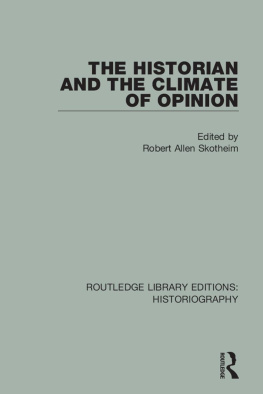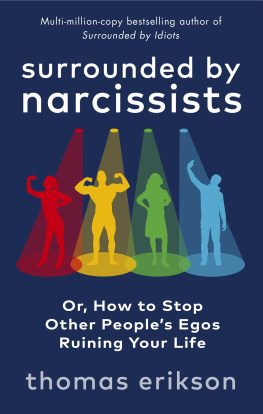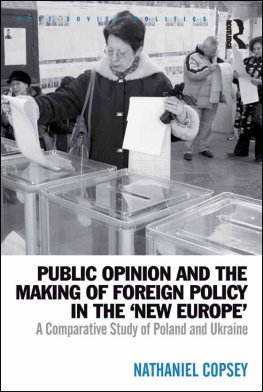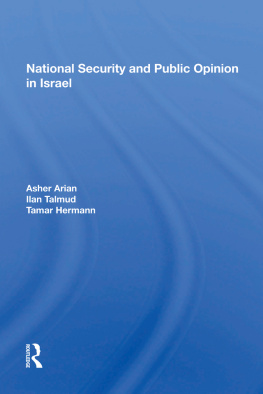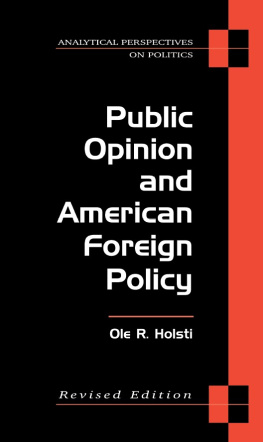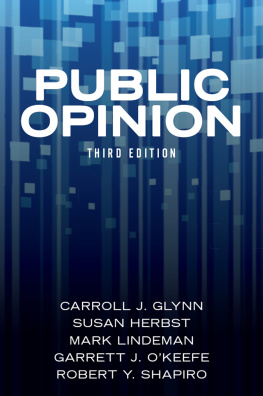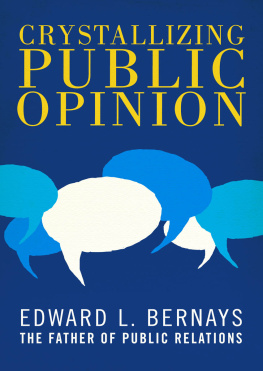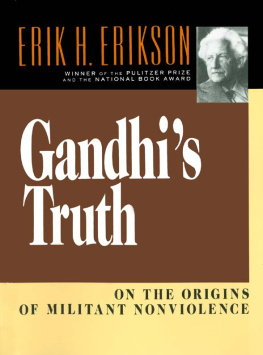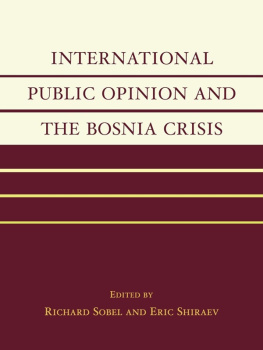Robert S Erikson - American Public Opinion: Its Origins, Content and Impact
Here you can read online Robert S Erikson - American Public Opinion: Its Origins, Content and Impact full text of the book (entire story) in english for free. Download pdf and epub, get meaning, cover and reviews about this ebook. year: 2015, publisher: Taylor and Francis, genre: Science / Politics. Description of the work, (preface) as well as reviews are available. Best literature library LitArk.com created for fans of good reading and offers a wide selection of genres:
Romance novel
Science fiction
Adventure
Detective
Science
History
Home and family
Prose
Art
Politics
Computer
Non-fiction
Religion
Business
Children
Humor
Choose a favorite category and find really read worthwhile books. Enjoy immersion in the world of imagination, feel the emotions of the characters or learn something new for yourself, make an fascinating discovery.
- Book:American Public Opinion: Its Origins, Content and Impact
- Author:
- Publisher:Taylor and Francis
- Genre:
- Year:2015
- Rating:4 / 5
- Favourites:Add to favourites
- Your mark:
- 80
- 1
- 2
- 3
- 4
- 5
American Public Opinion: Its Origins, Content and Impact: summary, description and annotation
We offer to read an annotation, description, summary or preface (depends on what the author of the book "American Public Opinion: Its Origins, Content and Impact" wrote himself). If you haven't found the necessary information about the book — write in the comments, we will try to find it.
American Public Opinion: Its Origins, Content and Impact — read online for free the complete book (whole text) full work
Below is the text of the book, divided by pages. System saving the place of the last page read, allows you to conveniently read the book "American Public Opinion: Its Origins, Content and Impact" online for free, without having to search again every time where you left off. Put a bookmark, and you can go to the page where you finished reading at any time.
Font size:
Interval:
Bookmark:

Opinion
Ninth Edition
Opinion
Robert S. Erikson
Columbia University
Kent L. Tedin
Columbia University

First published 2015, 2011, 2007 by Pearson Education, Inc.
Published 2016 by Routledge
2 Park Square, Milton Park, Abingdon, Oxon OX14 4RN
711 Third Avenue, New York, NY 10017, USA
Routledge is an imprint of the Taylor & Francis Group, an informa business
Copyright 2015, 2011, 2007 Taylor & Francis. All rights reserved.
All rights reserved. No part of this book may be reprinted or reproduced or utilised in any form or by any electronic, mechanical, or other means, now known or hereafter invented, including photocopying and recording, or in any information storage or retrieval system, without permission in writing from the publishers.
Notice:
Product or corporate names may be trademarks or registered trademarks, and are used only for identification and explanation without intent to infringe.
Credits and acknowledgments borrowed from other sources and reproduced, with permission, in this textbook appear on appropriate page within text.
ISBN: 9780133862676 (pbk)
Library of Congress Control Number:
2014939905
Dedicated to the memory of Maggie Banks Tedin (19472008), companion and wife of Kent Tedin for 32 years, and friend of Bob Erikson and his family.
In this ninth edition of American Public Opinion, we present an accounting of the role of public opinion in the democratic politics of the United States. As with previous editions, this book discusses the contemporary literature on public opinion, supplementing it with our own illustrations and analyses of contemporary public opinion data. It provides an in-depth analysis of public opinion, beginning with its origins in political socialization, the impact of the media, the extent and breadth of democratic values, and the role of public opinion in the electoral process. American Public Opinion is unique in that it goes beyond a simple presentation of data and discussion of the formation of opinion, to include a critical analysis of the role of public opinion in American democracy. As in previous editions, the ninth edition examines the relationship between public opinion and policy.
Readers familiar with the earlier eighth edition will notice few changes in format. The chapter titles are identical to those from the eighth edition. The within-chapter headings have changed little. Yet, because public opinion and electoral politics are always changing, each edition of this book requires extensive revision of content. In this ninth edition, we strive to keep the discussion as current as possible.
The ninth edition includes extensive discussion of public opinion on contemporary issues such as the Affordable Care Act (Obamacare) and gay marriage.
The ninth edition expands the discussion of whether the representation of public opinion is equal for all income groups.
The discussion of voters and elections is updated to focus on the 2012 presidential election, Obama vs. Romney.
The discussion of mass media and politics is revamped to offer more material on the influence of the Internet and social media.
The contemporary growth of political polarization and its causes is a theme weaved throughout the chapters of the ninth edition.
The ninth edition is updated to include both recent polls (through 2013) and the findings of the latest research on public opinion.
As this book has evolved through multiple editions, so too has the list of authors. The first edition (1973) was authored by Robert S. Erikson and Norman L. Luttbeg. With the second edition, Kent L. Tedin joined the team as a third author. That triumvirate held through three editions. By the time of the fifth edition, Luttbeg left the team to pursue other scholarly pursuits. This is the third edition solely authored by Erikson and Tedin. But Luttbegs contribution to the book remains, most notably in the five linkage models, which he originated.
The preparation of this volume relies heavily on the survey data of the National Election Studies, conducted by the University of Michigan, supported by grants from the National Science Foundation, and made available by the Interuniversity Consortium for Political and Social Research. We also relied extensively on the General Social Survey (also funded by the National Science Foundation) and the data available online from the Roper Center Data Archive at the University of Connecticut. These organizations bear no responsibility for the analysis or interpretations presented here. We are greatly indebted to them for making their data available to us and to other scholars on whose research we depend.
We benefit from the assistance provided by our editor, Melissa Mashburn, and to colleagues, students, and staff at Columbia University and the University of Houston. We are indebted to Prof. Kathleen Knight of Columbia University for her helpful advice. Special thanks go to Matthew Kantrowitz and David Llanos, for their invaluable research assistance.
Robert S. Erikson
Kent L. Tedin
Explain the historical development of the concept public opinion
Explain the evolution of the modern public opinion poll
Identify the main criticisms of the modern public opinion poll
Identify the political consequences of the modern public opinion poll
Few Americans in the twenty-first century can remember a time when public opinion pollslike television, shopping malls, and eight-lane freewayswere not part of the popular landscape. Polls tell us which television shows are the most popular, how frequently people attend church, what person Americans most admire, plus a myriad of opinions on current political topics. We shall see, however, that the study of public opinion is much broader than simply gauging popular reaction to recent events. It is, for example, also concerned with how people learn about government, their trust in existing political institutions, their support for the political rules of the game, the interrelationships among their opinions, and the trend toward political polarization that began more than fifteen years ago. The list could go on. But more than anything else, the study of public opinion is justified by the simple notion that democratic institutions should result in government decisions that reflect the views of everyday people. In the words of Robert Dahl, the most eminent political theorist of the post-World War II era, I assume that a key characteristic of a democracy is the continued responsiveness of the government to the preferences of its citizens, considered as political equals (1971, 1). It is this presumption, and its implications, that guides the systematic analysis of mass opinion.
Rousseau, in 1744, was among the first to use the term public opinion (lopinion publique), meaning the customs and manners of all members of society (as opposed to some elite). By 1780, French writers were using the term interchangeably with
Font size:
Interval:
Bookmark:
Similar books «American Public Opinion: Its Origins, Content and Impact»
Look at similar books to American Public Opinion: Its Origins, Content and Impact. We have selected literature similar in name and meaning in the hope of providing readers with more options to find new, interesting, not yet read works.
Discussion, reviews of the book American Public Opinion: Its Origins, Content and Impact and just readers' own opinions. Leave your comments, write what you think about the work, its meaning or the main characters. Specify what exactly you liked and what you didn't like, and why you think so.


